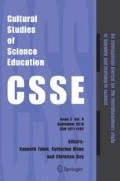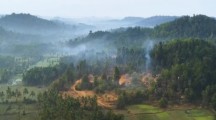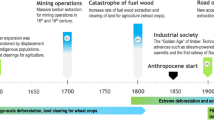Abstract
Considering that both Western Science and Local Knowledge Systems share a common ground—observations of the natural world—the dialogue between them should not only be possible, but fruitful. Local communities whose livelihoods depend on traditional uses of the local biodiversity not only develop knowledge about nature, making several uses of such knowledge, but, with that process, several inquiries about nature can be raised. Here we present our experience with the engagement of Western Science with golden grass artisan’s knowledge about the buriti palm (M. flexuosa). We applied 25 semi-directive interviews, combined with field diary and participative observation, in two quilombola communities from Jalapão region (Central-Brazil). One of the inquiries that emerged from the artisan’s perspectives was about the differences between male and female buriti palms’ fiber. We then engaged both local and scientific perspectives regarding this issue using plant anatomy as a dialogue instrument. Here we describe this experience and resort to Paulo Freire’s ideas on dialogue to argue that, to integrate Western Science and Local Knowledge Systems in a collaborative and contextualized perspective, the research should be faced as a mutual learning practice.

(Photos: M. Eichemberg)

(Photos: M. Eichemberg)

(Photos: V. Scatena (3a) and M. Eichemberg (3b–d))
Similar content being viewed by others
References
Aikenhead, G., & Michell, H. (2011). Bridging cultures: Scientific and indigenous ways of knowing nature. Ontario: Pearson Canada Inc.
Alexiades, M. N. (1996). Collecting ethnobotanical data: An introduction to basic concepts and techniques. In M. N. Alexiades (Ed.), Selected guidelines for ethnobotanical research: A field manual (pp. 53–97). New York: The New York Botanical Garden.
Bardin, L. (2004). Análise de Conteúdo (3rd ed., p. 70). Lisboa: Edições p.
Bogdan, R., & Biklen, S. (2006). Investigação qualitativa em educação: uma introdução às teorias e aos métodos. Porto: Porto Editora.
Cunha, M. C. (2009). Relações e dissenções entre saberes tradicionais e saber científico. In M. C. Cunha (Coord.), Cultura com Aspas (pp. 301–310). São Paulo: Cosac-Naify.
Cunha, M. C. (2012). Questões suscitadas pelo conhecimento tradicional. Revista de Antropologia, 55(1), 439–464.
Diaz, S., Demissew, S., Carabias, J., Joly, C., Lonsdale, M., Ash, N., et al. (2015). The IPBES conceptual framework: Connecting nature and people. Current Opinion in Environmental Sustainability, 14, 1–16. doi:10.1016/j.cosust.2014.11.002.
El-Hani, C. N., & Bandeira, F. P. S. F. (2008). Valuing indigenous knowledge: to call it “science” will not help. Cultural Studies of Science Education, 3, 751–779. doi:10.1007/s11422-008-9129-6.
Elo, S., & Kyngas, H. (2008). The qualitative content analysis process. Journal of Advanced Nursing, 62(1), 107–115. doi:10.1111/j.1365-2648.2007.04569.x.
Feder, N., & O’Brien, T. P. (1968). Plant microtechnique: Some principles and new methods. American Journal of Botany, 55, 123–142.
Freire, P. (2011). A dialogicidade: essência da educação como prática da liberdade. In P. Freire (Ed.), Pedagogia do oprimido (50th ed., pp. 107–166). Rio de Janeiro: Paz e Terra.
Future Earth. (2014). Future Earth 2025 vision. Paris: Future Earth. Retrieved from: http://www.futureearth.org/sites/default/files/files/Future-Earth_10-year-vision_web.pdf.
Hsieh, H., & Shannon, S. E. (2005). Three approaches to qualitative content analysis. Qualitative Heath Research, 15(9), 1277–1288. doi:10.1177/1049732305276687.
Huntington, H. P. (1998). Observations on the utility of the semi-directive interview for documenting traditional ecological knowlegde. Artic, 51(3), 237–242.
Huntington, H. P. (2000). Using traditional ecological knowledge in science: Methods and applications. Ecological Applications, 10(5), 1270–1274. doi:10.2307/2641282.
Huntington, H. P. (2011). Artic science: The local perspective. Nature, 478, 182–183.
Johansen, D. (1940). Plant microtechnique. New York: McGraw-Hill Book Co., Inc.
Lowan, G. (2012). Expanding the conversation: Further explorations into indigenous environmental science education theory, research, and practice. Cultural Studies of Science Education, 7, 71–81. doi:10.1007/s11422-012-9379-1.
Mack, E., Augare, H., Cloud-Jones, L. D., Davíd, D., Gaddie, H. Q., Honey, R. E., et al. (2012). Effective practices for creating transformative informal science education programs grounded in native ways of knowing. Cultural Studies of Science Education, 7, 49–70. doi:10.1007/s11422-011-9374-y.
Mazzolcchi, F. (2006). Western science and traditional knowledge. European Molecular Biology Organization, 7(5), 463–466.
Roeser, K. R. (1972). Die nadel der schwarzkiefer massen produkt und keinstwerk der natur. Mikrokosmos, 61, 33–36.
Sampaio, M. B., Schmidt, I. B., & Figueiredo, I. B. (2008). Harvesting effects and population ecology of the buriti palm (Mauritia flexuosa L. f., Arecaceae) in the Jalapão region, Central Brazil. Economic Botany, 62(2), 171–181. doi:10.1007/s12231-008-9017-8.
Sampaio, M. B., Ticktin, T., Seixas, C. S., & Santos, F. A. M. (2012). Effects of socioeconomics conditions on multiple uses for swamp forests in central Brazil. Human Ecology, 40, 821–831. doi:10.1007/s10745-012-9519-y.
Schmidt, I. B., Figueiredo, I. B., & Scariot, A. (2007). Ethnobotany and effects of harvesting on the population ecology of Syngonanthus nitens (Bong.) Ruhland (Eriocaulaceae), a NTFP from Jalapão region, Central Brazil. Economic Botany, 6(1), 73–85. doi:10.1663/0013-0001(2007)61[73:EAEOHO]2.0.CO;2.
Schmidt, I. B., Sampaio, M. B., Figueiredo, I. B., & Ticktin, T. (2011). Fogo e artesanato de capim-dourado no Jalapão: usos tradicionais e consequências ecológicas. Biodiversidade Brasileira, 2, 67–85.
Schmidt, I., & Ticktin, T. (2012). When lessons from population models and local ecological knowledge coincide: Effects of flower stalk harvesting in the Brazilian savanna. Biological Conservation, 152, 187–195. doi:10.1016/j.biocon.2012.03.018.
UNESCO. (2000). Declaration on science and the use of scientific knowledge. In World Conference on Science. Science for the Twenty-first Century a New Commitment (pp. 462–467). London: UNESCO. Retrieved from: http://www.unesco.org/science/wcs/eng/declaration_e.htm.
United Nations. (Rio de Janeiro, 1992). Convention on Biological Conservation. United Nations. Retrieved from: http://www.cbd.int/doc/legal/cbd-en.pdf.
United Nations. (Rio de Janeiro, 3 to 14 June, 1992). United Nations Conference on Environmental & Development - Agenda 21. Retrieved from: https://sustainabledevelopment.un.org/content/documents/Agenda21.pdf.
Vanderbroek, I., Reyes-Garcia, V., Albuquerque, U. P., Bussmann, R., & Pieroni, A. (2011). Local knowledge: Who cares? Journal of Ethnobiology and Ethnomedicine, 7(35), 1–12. doi:10.1186/1746-4269-7-35.
Viana, R. V. R. (2013). Diálogos possíveis entre saberes científicos e locais associados ao capim- dourado e ao buriti na região do Jalapão, TO. Master dissertation presented at the Botany Post graduation Program, Instituto de Biociências, Universidade de São Paulo.
Viana, R. V. R., Sano, P. T., & Scatena, V. L. (2014). Pesquisa de campo como possibilidade de concretizar oportunidades de diálogo: experiências em duas comunidades artesãs do Japalão: TO. Revista de Desenvolvimento Social, 13, 57–67.
Acknowledgments
The authors thank FAPESP (Fundação de Amparo à Pesquisa do Estado de São Paulo; Grant 2010/14534-9) and CNPq (Conselho Nacional de Desenvolvimento Científico e Tecnológico; Grants 307100/2009-0 and 301692/2001-6); Idea Wild and Neotropical Grasslands Conservancy for financial support; NATURATINS (Instituto Natureza do Tocantins) and PEQUI (Pesquisa e Conservação do Cerrado) for the logistic support. We would also like to thank the CSSE revisor careful revision, that certainly enhanced this article quality. We are deeply grateful to people from Jalapão, especially those from Mumbuca and Prata.
Author information
Authors and Affiliations
Corresponding author
Additional information
Lead editor: C. Castano Rodriguez.
Rights and permissions
About this article
Cite this article
Viana, R.V.R., Scatena, V.L., Eichemberg, M.T. et al. Engaging plant anatomy and local knowledge on the buriti palm (Mauritia flexuosa L.f.: Arecaceae): the microscopic world meets the golden grass artisan’s perspective. Cult Stud of Sci Educ 13, 253–265 (2018). https://doi.org/10.1007/s11422-016-9785-x
Received:
Accepted:
Published:
Issue Date:
DOI: https://doi.org/10.1007/s11422-016-9785-x




